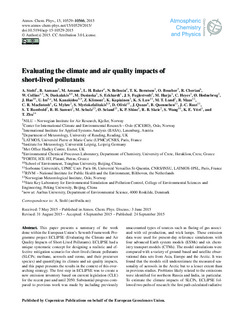| dc.identifier.citation | Stohl, A., Aamaas, B., Amann, M., Baker, L.H., Bellouin, N., Berntsen, T.K., Boucher, O., Cherian, R., Collins, W., Daskalakis, N., Dusinska, M., Eckhardt, S., Fuglestvedt, J.S., Harju, M., Heyes, C., Hodnebrog, Ø., Hao, J., Im, U., Kanakidou, M., Klimont, Z., Kupiainen, K., Law, K.S., Lund, M.T., Maas, R., MacIntosh, C.R., Myhre, G., Myriokefalitakis, S., Olivié, D., Quaas, J., Quennehen, B., Raut, J.-C., Rumbold, S.T., Samset, B.H., Schulz, M., Seland, Ø., Shine, K.P., Skeie, R.B., Wang, S., Yttri, K.E., Zhu, T. (2015) Evaluating the climate and air quality impacts of short-lived pollutants. Atmos. Chem. Phys., 15, 10529-10566. doi:10.5194/acp-15-10529-2015. | nb_NO |
| dc.description.abstract | This paper presents a summary of the work done within the European Union's Seventh Framework Programme project ECLIPSE (Evaluating the Climate and Air Quality Impacts of Short-Lived Pollutants). ECLIPSE had a unique systematic concept for designing a realistic and effective mitigation scenario for short-lived climate pollutants (SLCPs; methane, aerosols and ozone, and their precursor species) and quantifying its climate and air quality impacts, and this paper presents the results in the context of this overarching strategy. The first step in ECLIPSE was to create a new emission inventory based on current legislation (CLE) for the recent past and until 2050. Substantial progress compared to previous work was made by including previously unaccounted types of sources such as flaring of gas associated with oil production, and wick lamps. These emission data were used for present-day reference simulations with four advanced Earth system models (ESMs) and six chemistry transport models (CTMs). The model simulations were compared with a variety of ground-based and satellite observational data sets from Asia, Europe and the Arctic. It was found that the models still underestimate the measured seasonality of aerosols in the Arctic but to a lesser extent than in previous studies. Problems likely related to the emissions were identified for northern Russia and India, in particular. To estimate the climate impacts of SLCPs, ECLIPSE followed two paths of research: the first path calculated radiative forcing (RF) values for a large matrix of SLCP species emissions, for different seasons and regions independently. Based on these RF calculations, the Global Temperature change Potential metric for a time horizon of 20 years (GTP20) was calculated for each SLCP emission type. This climate metric was then used in an integrated assessment model to identify all emission mitigation measures with a beneficial air quality and short-term (20-year) climate impact. These measures together defined a SLCP mitigation (MIT) scenario. Compared to CLE, the MIT scenario would reduce global methane (CH4) and black carbon (BC) emissions by about 50 and 80%, respectively. For CH4, measures on shale gas production, waste management and coal mines were most important. For non-CH4 SLCPs, elimination of high-emitting vehicles and wick lamps, as well as reducing emissions from gas flaring, coal and biomass stoves, agricultural waste, solvents and diesel engines were most important. These measures lead to large reductions in calculated surface concentrations of ozone and particulate matter. We estimate that in the EU, the loss of statistical life expectancy due to air pollution was 7.5 months in 2010, which will be reduced to 5.2 months by 2030 in the CLE scenario. The MIT scenario would reduce this value by another 0.9 to 4.3 months. Substantially larger reductions due to the mitigation are found for China (1.8 months) and India (11–12 months). The climate metrics cannot fully quantify the climate response. Therefore, a second research path was taken. Transient climate ensemble simulations with the four ESMs were run for the CLE and MIT scenarios, to determine the climate impacts of the mitigation. In these simulations, the CLE scenario resulted in a surface temperature increase of 0.70 ± 0.14 K between the years 2006 and 2050. For the decade 2041–2050, the warming was reduced by 0.22 ± 0.07 K in the MIT scenario, and this result was in almost exact agreement with the response calculated based on the emission metrics (reduced warming of 0.22±0.09K). The metrics calculations suggest that non-CH4 SLCPs contribute ~ 22% to this response and CH4 78%. This could not be fully confirmed by the transient simulations, which attributed about 90% of the temperature response to CH4 reductions. Attribution of the observed temperature response to non-CH4 SLCP emission reductions and BC specifically is hampered in the transient simulations by small forcing and co-emitted spec | nb_NO |

